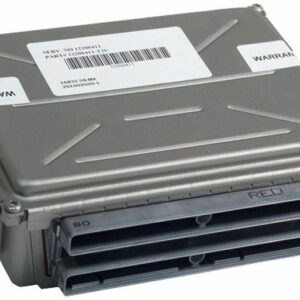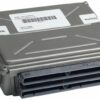Get Your GM Truck Running Right Again
Is your 2003-2007 Sierra 2500, or another compatible GM truck, suddenly giving you headaches? Maybe it’s a persistent Check Engine Light, a frustrating no-start condition, or rough performance that just won’t go away. Before you assume the worst, the problem often lies with a failing Powertrain Control Module (PCM)—the central computer of your vehicle. This isn’t just a replacement part; it’s a direct solution, delivered to your door programmed and ready to install. We take your vehicle’s VIN and flash this module with the latest, most stable software from GM, ensuring it communicates perfectly with your truck from the moment you plug it in.
A Technician’s Notebook: The Intermittent No-Start Nightmare
I once had a 2006 Silverado 2500 in my bay that was driving its owner crazy. It would start perfectly for a week, then refuse to crank for two days straight, with no rhyme or reason. The battery was new, the starter checked out, and there were no obvious wiring issues. After hours of diagnostics, we finally caught the culprit: the PCM was intermittently failing its internal self-check, a classic sign of a processor fault (DTC P0606). The owner was dreading a tow to the dealership and a hefty bill for a new module and programming. Instead, we ordered a VIN-programmed unit just like this one. It arrived, we swapped it in 15 minutes, and the truck fired up instantly. That was two years ago, and it hasn’t missed a start since. This is the exact fix for those ghost-in-the-machine problems.
Is Your GM Truck Showing These Signs of PCM Failure?
A failing PCM can cause a wide range of confusing symptoms. If you’re experiencing any of the following, a faulty engine computer is a likely cause. In my 20+ years of experience, these are the most common indicators I’ve seen in the shop:
- ✔ Persistent Check Engine Light (CEL) that won’t clear.
- ✔ Diagnostic Trouble Codes (DTCs) related to the module itself, such as P0601 (Internal Control Module Memory Check Sum Error) or P0606 (ECM/PCM Processor Fault).
- ✔ Unexplained no-start or hard-starting conditions.
- ✔ Sudden stalling, rough idling, or engine hesitation.
- ✔ A noticeable drop in fuel economy.
- ✔ Harsh or erratic automatic transmission shifting.
- ✔ Failure to pass state emissions inspections.
A Straightforward Guide to Your PCM Installation
One of the biggest benefits of this module is that the hard part—the programming—is already done. The physical installation is something a confident DIYer can handle with basic tools. This guide is for a typical GM truck application where the PCM is located under the battery.
- Safety First: Always disconnect the negative terminal from your vehicle’s battery and secure it away from the post to prevent any accidental reconnection.
- Access the Module: You will likely need to remove the battery and the battery tray to access the PCM. It’s typically mounted to the side of the engine bay on the driver’s side.
- Disconnect the Old PCM: The PCM has several large multi-pin connectors. Each one has a locking tab or lever. Carefully release the locks and gently pull the connectors straight out. Never force them.
- Swap the Modules: Unbolt the old PCM from its mounting bracket. Place the new, pre-programmed module in the same position and secure it with the original hardware.
- Reconnect and Secure: Plug the wiring harness connectors firmly into the new PCM. You should feel or hear them click into place. Secure the locking levers.
- Final Steps: Reinstall the battery tray and the battery, then reconnect the negative battery terminal. Your vehicle is now ready to start. In some cases, a security relearn procedure may be required, which typically involves cycling the key and can be done without special tools.
Verified Vehicle Compatibility
This Powertrain Control Module, service number 12582605, is a direct-fit replacement for a wide range of GM trucks and SUVs. It is also a compatible replacement for service numbers 89017750, 12589463, 12602802, 89017734, and 28042802. Please verify your vehicle is on the list below. Note that for some 2004 and 2007 models, matching the ID number or body style is important.
GMC
- ✔ Sierra 1500 Pickup: 2003-2006 (w/o 4.3L), 2007 Classic (w/o 4.3L)
- ✔ Sierra 2500 Pickup: 2003-2006 (Gas 6.0L), 2007 Classic (Gas 6.0L)
- ✔ Sierra 3500 Pickup: 2003-2006 (Gas 6.0L), 2007 Classic (Gas 6.0L)
- ✔ Sierra Denali: 2003-2006, 2007 Classic
- ✔ Yukon / Yukon XL 1500: 2003-2006
- ✔ Yukon XL 2500: 2003-2006 (6.0L)
- ✔ Envoy XL: 2003 (5.3L)
Chevrolet
- ✔ Silverado 1500 Pickup: 2003-2006 (w/o 4.3L), 2007 Classic (w/o 4.3L)
- ✔ Silverado 2500 Pickup: 2003-2006 (Gas 6.0L), 2007 Classic (Gas 6.0L)
- ✔ Silverado 3500 Pickup: 2003-2006 (Gas 6.0L), 2007 Classic (Gas 6.0L)
- ✔ Avalanche 1500: 2003-2006
- ✔ Suburban 1500: 2003-2006
- ✔ Suburban 2500: 2003-2006 (6.0L)
- ✔ Tahoe: 2003-2006
- ✔ SSR: 2003
- ✔ Trailblazer EXT: 2003 (5.3L)
Cadillac
- ✔ Escalade: 2003-2006
- ✔ Escalade ESV: 2003-2006
- ✔ Escalade EXT: 2003-2006
Hummer
- ✔ H2: 2003-2007
Isuzu
- ✔ Ascender: 2003 (5.3L)
Frequently Asked Questions
Frequently Asked Questions
How do I provide my VIN for programming?
After you complete your purchase, simply send us a message with your 17-digit Vehicle Identification Number (VIN). We cannot ship the module until we receive this information, as the programming is specific to your exact vehicle.
Do I need a dealership or mechanic to install this?
No. Because we program the module before shipping, you do not need any special scan tools for programming. The physical installation is straightforward for many DIYers with basic hand tools. However, if you are not comfortable working on your vehicle, we always recommend professional installation.
My old part number is not 12582605 but is on the compatible list. Will this work?
Yes. Manufacturers often update part numbers over time. This module is the correct service replacement for all the numbers listed, including 89017750, 12589463, 12602802, and others. As long as your vehicle is on the fitment list, this part will function correctly.
What if I install it and my problem doesn’t go away?
While this PCM is a common solution for many electronic issues, proper diagnosis is key. If a new PCM does not solve your issue, it’s likely the problem lies with another component, such as a sensor or wiring harness. We recommend confirming the diagnosis before purchase.
Is any other setup required after installation?
In most cases, no. It’s designed to be plug-and-play. On some vehicles, an anti-theft security relearn procedure may be necessary. This procedure does not require special tools and instructions can typically be found online or in your owner’s manual.



